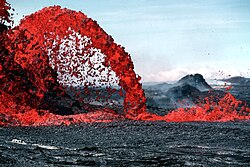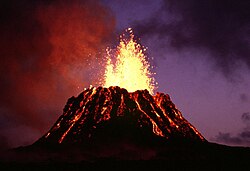Shield volcano
"Shield volcanoes" redirects here.
A shield volcano is a large volcano with shallowly-sloping sides. The name derives from a translation of "Skjaldbreiður", an Icelandic shield volcano whose name means "broad shield," from its resemblance to a warrior's shield.
Shield volcanoes are usually formed by lava that flows easily. Consequently, a volcanic mountain having a broad profile is built up over time by flow after flow of relatively fluid basaltic lava issuing from vents or fissures on the surface of the volcano. Many of the largest volcanoes on Earth are shield volcanoes.
The largest is Mauna Loa on the Big Island of Hawaii. Shield volcanoes can be so large they are sometimes considered a mountain range, such as the Ilgachuz Range and the Rainbow Range, both of which are in Canada. These shield volcanoes formed when the North American Plate moved over a hotspot similar to the one feeding the Hawaiian Islands, called the Anahim hotspot. There are also shield volcanoes, for example, in Washington, Oregon, and the Galapagos Islands. The Piton de la Fournaise, on Réunion Island, is one of the more active shield volcanoes on earth, with one eruption per year on average.
Shield volcanoes are known to form on other planets. The largest known mountain in the solar system, Olympus Mons on Mars, is a shield volcano. Shield volcanoes on Mars are higher and much more massive than those on Earth.
On Earth, because of plate tectonics, hotspot volcanoes eventually move away from the source of their magma and the volcanoes are individually less massive than might otherwise be the case. Shield volcanoes usually occur along constructive boundaries or above hotspots. However, the many large shield volcanoes of the Cascade Range of northern California and Oregon are over a more complex environment.
On other planets
Shield volcanoes are not only found on Earth, they can also be found on Mars, Venus, and Io, which is a moon of Jupiter. The volcanoes on Mars are bigger than those on Earth.
Shield Volcano Media
Mauna Loa, a shield volcano in Hawaii
An Ancient Greek warrior's shield—its circular shape and gently sloping surface, with a central raised area, is a shape shared by many shield volcanoes.
Skjaldbreiður is a shield volcano in Iceland, whose name means broad shield in Icelandic.
Scaled image showing Olympus Mons, top, and the Hawaiian island chain, bottom. Martian volcanoes are far larger than those found on Earth.
A pāhoehoe lava fountain on Kīlauea erupts
Pāhoehoe flows enter the Pacific Ocean on Hawaiʻi island
Puʻu ʻŌʻō, a parasitic cinder cone on Kīlauea, lava fountaining at dusk in June 1983, near the start of its eruptive cycle
Nāhuku, a lava tube on Hawaiʻi island, now a tourist attraction in the Hawaiʻi Volcanoes National Park
Related pages
References
- Douglas Harper (2010). "Shield volcano". Online Etymology Dictionary. Douglas Harper. Retrieved February 13, 2011.
- "How Volcanoes Work: Basaltic Lava". San Diego State University. Archived from the original on 8 October 2018. Retrieved 2 August 2010.
Other websites
- Media related to Shield volcanoes at Wikimedia Commons
- "Shield volcano" at Oxford English Dictionary











